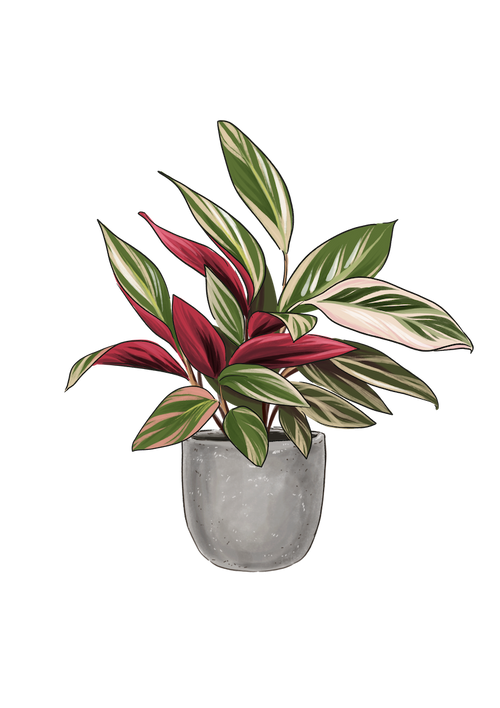Stromanthe Tricolor Care Guide

-
Light : High
Bright, indirect light is the best for this plant.
-
Water : Medium
Keep this plant consistently moist but not soggy. Use filtered, bottled, or tap water sitting 24 hours to release the chemicals and water enough that the water discharges out of the drainage holes. Avoid overwatering as it can suffer from root rot. Let it dry out a little more in the winter when it's in dormancy and not actively growing.
-
Humidity : High
The Stromanthe tricolor likes high amounts of humidity. To achieve this keep it on a pebble tray, close to a humidifier or keep it covered in a vented garden cloche dome.
-
Temp : 60℉ - 75℉
Keep this plant in rooms where the temperature is a comfortable 65°F-75°F and avoid cold drafts or air vents below 60°F. It thrives in warmer temperatures with plenty of humidity.
-
Zone : 9|10|11
Outside: Grow in morning dappled light, or medium indirect light where nights are above 60°F. Indoors: The Stromanthe plant prefers bright to medium, indirect light in an east or southern facing window.
-
Fertilizer : Every two weeks
Fertilize twice a month by diluting a liquid fertilizer into the water while watering. Use half the recommended strength. Fertilize monthly during the growing season but let the plant rest in the fall and winter.
-
Repotting : 2 Years
When receiving the Stromanthe triostar plant, do not repot immediately but wait at least 6-12 months or if the roots are beginning to get crowded and growing through the drainage holes. Repot in the spring, using a 2 inches bigger pot to keep the roots drier. (Too big of a planter could cause the soil to dry slower.) Place a piece of screening at the bottom of the container over the drainage hole to secure the soil and allow it to drain.Use a well-draining indoor potting mix with perlite to help with drainage. Water your plant in the old pot before transferring over and let it sit an hour. Add a combination of rich indoor potting soil mix amended with coco coir and perlite to the bottom to elevate the root ball. Lift the plant and release the roots against the existing planter. Use a clean knife or garden trowel to wedge between the pot and the soil to loosen. Inspect the root ball. Notice if there are any dead or rotting roots and trim off with sterile pruners. If the plant is rootbound, cut through the roots to alleviate continued encircling. Ensure the plant is sitting about 1/2 inch below the edge of the pot to avoid water spillage. Add more soil mix and backfill around the sides by tamping down. Fill up to the soil line but not over. Water thoroughly, leaving the soil damp but not soggy. If settling occurs, add more soil. Water well to dampen the soil and let it drain.
-
Cleaning : Monthly
Trim off any dead or damaged stems to keep energy moving to the healthy leaves. Shower the leaves using a watering can with filtered or rainwater to remove dust. Remove any debris on the soil and replenish soil if needed.
-
Propagation : Division
Indoors: Propagate and divide the Stromanthe tricolor plants in the early spring when emerging from dormancy. Pull from the container and brush or wash away the soil carefully. Carefully divide and repot in a rich, indoor potting soil mix amended with coconut coir and perlite. Use a container that has drainage and is deep enough for the roots to grow. Set it in medium to bright, indirect sunlight while they are rooting. Enclose the new plantings in plastic bags, mist and keep them in medium light. Remove the plastic bag when the roots are established. You may observe some leaf changes as it acclimates to its new environment. It may suffer some transplant shock depending on how tight the roots were intertwined together. Trim off any declining leaves as it regains its energy and gets rooted into the soil over time. Check the moisture and humidity each day and add misting to keep the soil moist while the roots establish. After 6-8 weeks, roots will begin to establish. You can tug onto the stem to ensure the roots are anchoring well.













